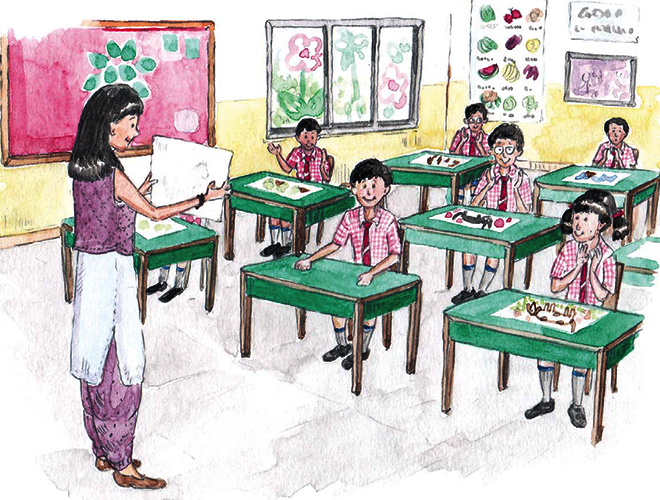Nitin woke up early as usual and got ready for school. But today, he was excited because it was the last day of school, and also the day of his favourite exam—drawing.
“I can’t wait for the vacations to start!” he thought, as he went to have breakfast.
Nitin’s grandfather was seated in the living room browsing through an old photo album.
“Whose photos are these, Grandpa?” asked Nitin, looking at the photos.
“They are all mine. They were taken when I used to live in the village with your grandmother,” replied Grandpa.
“See this one,” said Grandpa, pointing to one of the photos. “That’s your mother when she was six years old.”
“Wow! I can’t imagine Ma as a little girl,” said Nitin, looking at the photos curiously. “But Grandpa, why are there no colours in these photos?”
“At the time when these photos were taken, the cameras we had didn’t take colour photos. That technology came in much later. So, all the photos you see are in shades of black and white,” explained Grandpa.
Just then, Nitin’s mother called out to him. “Nitin, are you ready? It’s almost time to leave,” she said.
Nitin quickly finished his breakfast and started packing his bag. He had kept all his drawing stuff on the sofa. He put the drawing board, pencil box and a box of colour pencils into his bag.
Nitin did not notice that the box with the colour pencils was open and that many of them had fallen out. He quickly closed his bag and rushed to school.

At school, all the children were excited about the last day of school. They discussed their plans for the summer vacation.
When the bell rang, they went to their respective classrooms and took their seats for the exam.

In the class, Nitin’s art teacher announced the topic for the exam:
1. A village scene
2. Wildlife
3. Water conservation
Nitin was eager to start drawing. He took out his pencil box, drawing board and box of colour pencils from inside his bag and arranged them on the desk. That is when he noticed that most of the colour pencils were missing. He frantically searched his bag thinking they may have fallen inside, but they were not there either.
“Oh no! How will I draw without my colour pencils?” Nitin panicked.
Nitin’s art teacher saw him looking worried. When she realised that he did not have his colour pencils, she said, “Don’t worry, Nitin. You can borrow from your friends once they have finished their drawing.”
Nitin thanked his teacher but he knew that if he had to wait for his classmates to finish, then he would not able to finish his painting.
Nitin looked at the colours he had in the box: black, blue, brown and white. He wondered if he could draw something using just these colours. He then remembered the black and white photos in his grandfather’s album. He also remembered seeing a photo of Grandpa on a horse in his farm.
“It is a stunning picture. I could recreate that on paper, and it requires only two colours,” thought Nitin and began to draw.

Nitin began by drawing the outline of a horse with a pencil and then filled it mostly with black colour and added bits of grey to give the effect of light. Once he was satisfied with it, he proceeded to draw a man on a horse. For the man, he added more shades of grey, black and white to add details of clothing and facial features.
At the end of the hour, when the bell rang, the students submitted their drawings to the teacher.
While their teacher graded each one, all of them, except Nitin, waited eagerly for the results. Nitin was not happy with the drawing he had submitted. Though it was technically good, he thought it would have been better in colour.
After a while, their teacher distributed the drawings back to the students along with their grades marked on them.
Nitin’s name was the last to be called out. He was sure the teacher was going to scold him for submitting a black and white drawing. Instead, she smiled at him.

Nitin’s teacher displayed his drawing for everyone to see and said, “Nitin has primarily used only two colours in his drawing. See how beautiful it looks and the details are highlighted with just two colours. I especially appreciate him because even though he did not have most of his colour pencils, he made the most of whatever he had instead of giving up.”
Nitin beamed on hearing his teacher’s words. It was the best ending to the last day of school!







